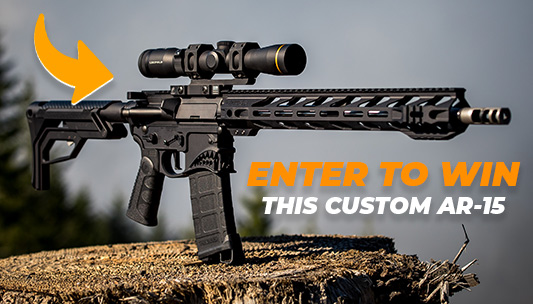Skill Level
Visualization Techniques Will Make You A Better Shooter
Published
2 years agoon

Learn how to become a better and more responsible gun owner through visualization techniques and regulated breathing.
Visualization Techniques For Better Shooting Skills
In this article:
- How Visualization Techniques Makes You Focus More
- Visualization Techniques In Athletes
- The Key To Visualization
- Visualization Techniques in Carrying and Using Guns
- Techniques to Follow
- Anchors to Help You Focus
- The Shooting Zone
- Manage Stress While Shooting
How Visualization Techniques Makes You Focus More
The best athletes do it daily, before every practice, before every game, and even after; average players don’t.
George Mumford, who was the “meditation coach” for Phil Jackson’s NBA teams and author of the book, The Mindful Athlete, calls it “being in flow.” Writers, actors, and artists do it too. The “it” in question is visualization, or your ability to see success in your mind before you do an important activity.
Visualization Techniques In Athletes
When athletes are “in the zone,” they say that the ball they use is bigger and moving slower. Baseball players who use visualization techniques swear they can see the stitches spinning toward them at the plate. Football and basketball players hear the crowd become quiet in their minds and the ball is perfectly frozen for a split-second before it leaves or enters their hands.
For them, the process of visualization starts in a quiet room, alone or with their teammates, where they internally map out what the steps to success in their sport look like to them. With their eyes closed and their focus on full attention, they walk through the process of being skilled and successful: “Here’s me at the free throw line. I bounce the ball three times. My hands are in perfect position. My shooting hand bends perfectly and the ball moves in a perfect arc to the rim and through the net.”
Repeating this process, over and over in their minds, becomes a part of their off-the-field routine, so when they get on the field or court, it seems like “déjà vu all over again.”
The Key To Visualization
The key to visualization success is exactly that: seeing success, never failure.
Top PGA golfer Dustin Johnson would never start a visualization exercise by saying, “Here’s me shanking one off into the woods. Here’s me missing a three-foot putt. Here’s me heaving my clubs into the lake.”
Visualization is always about doing it perfectly so that your mind and body can memorize the visual and “haptic” (kinesthetic, hands-on) movements when you need to be your best.
Visualization Techniques in Carrying and Using Guns

When it comes to success in concealed carry, we’re talking life-and-death decisions, often made in less than five seconds. You don’t have all the time in the world to stop and think about where your gun is on your body, what it takes to draw it safely, quickly, and on target, and be ready to fire or not fire. Those actions better be part of your muscle memory and they need to be done in your mind and cemented through hundreds of physical repetitions, until you don’t “think,” you just “do.”
Techniques to Follow
Here’s how the process can work: Once per day, when it’s quiet and you’re alone, sit and close your eyes. Spend five to ten minutes walking your mind through your process from concealed carry to full draw on target.
You’ll have your own drawing method. Here's what I usually think of:
- Clear my clothing.
- Grip my handgun securely.
- Make a smooth, safe, and fast draw from my holster.
- Keep finger out of the trigger until I’m on target and ready to fire.
- Move my off hand to my gun hand and bring them together in my usual perfect grip.
- Get both eyes on my target.
- Quickly align my sight picture, with my focus on my front sight clear and the target now slightly blurred.
- My finger on the trigger as I make the decision if I need to fire.
- Repeat.
You can also create a similar visualization process for success at the range involving the following:
- Sight portrait
- Breath control
- Hand positioning
- Grip strength
- Stance
- Trigger finger positioning and pressure
Be mindful of resetting your trigger each time, making adjustments as you see what you’re hitting on the target.
Anchors to Help You Focus

And while visualization works, you’ll need another tool to make it fully operational: an anchor.
Anchors are small physical points that help you activate your mind and body after you’ve already thought about your process and practiced it. We already have a lot of anchors in our lives, based on the things we touch, taste, see, smell, or hear.
If you smell an apple pie and it makes you think of your grandma’s house, that’s an anchor. Grabbing a baseball could be an anchor to your childhood. Some anchors are positive (seeing a happy puppy run over for petting) and others are negative (re-seeing a bad car accident you witnessed every time you go through that same intersection).
The Shooting Zone
For concealed carry or at the range, your touch anchor might kick in when you first grip your gun. As well as when both of your hands come together on your pistol to create that feeling of strength and solidarity. It could also be by quickly blinking your eyes to create that moment when your sight picture becomes clear and focused. That's when you’ve moved into the Shooting Zone.
However, to stay in the Shooting Zone, you must manage your breathing, especially during any potential armed confrontation. You can visualize stress-managed breathing as well.
Manage Stress While Shooting
You can tell you're getting stressed when your breathing starts becoming shallow and rapid in short intervals. On the other hand, stress-managed breathing is long, deep, and slow. Skilled shooters learn to control their breathing at the range and especially in the uncontrolled environment out in the streets. You won't be able to concentrate with your heart pounding away in your chest and your breathing taking up your attention.
Less oxygen in your brain pushes your body into fight-or-flight mode faster than you need. Your blood drains from your brain and into your lower extremities, giving you tunnel vision and hearing. None of this is good for your judgment, reactions, or safety.
When your life is on the line, breathe in a cycle: inhale, hold briefly, exhale, hold briefly, inhale, hold, etc. Practice “combat breathing” when things are safe around you. To do this slow and deep breathing technique, concentrate on the length of each breath and spend a moment on those transitions between the end of each inhalation and the start of the next exhalation.
Learn more about breathing right to aid you with your visualization techniques. Watch this video from Rated Red:
Start your visualization techniques and stress breathing practice sessions with five minutes at a time, work up to ten, on all the days of the week that end in the letter y. This will definitely help you have more control when shooting or facing a situation where you need to use your gun.
What do you think of this post on visualization techniques? Let us know in the comment section below.
Up Next: Police Trade-In Guns | Sig Sauer P229 .40 S&W
Editor's Note: This post was originally published on March 22, 2017, and has been updated for quality and relevancy.
Originally posted on October 2, 2018 @ 9:00 AM


Valentine’s Day Gift Guide: Thoughtful Ideas for Gun Enthusiasts

Battle for Gun Rights in 2025: Key Wins and Ongoing Challenges ️

Myths About Revolvers: Unraveling the Truth in 2025

Master the Basics: How to Prepare for Your First USPSA Match This Spring

Everyday Carry Knife: Why Concealed Carriers Shouldn’t Go Without One

Handgun Designs: From Historic Flintlocks to Modern Innovations




Dave
April 2, 2017 at 9:53 PM
Reminds me of when I was a kid. My grandfather would place an empty beer can on a fence post and let us take turns trying to hit it with his new 357. My mother would stand on the line, look at the can, close her eyes, and hit it almost every time. She visualized the can and it went flying. This is a woman who never had any training. Didn’t even have any experience. Perhaps what she did have was an artistic eye. She was an artist and her drawing of longhorns seemed so real it was like you could reach out and run your hands through the hair.